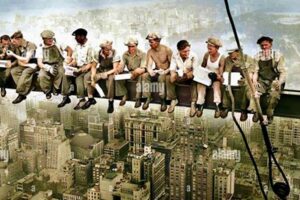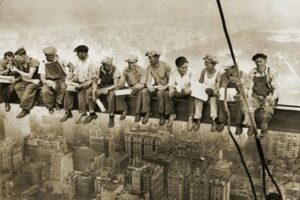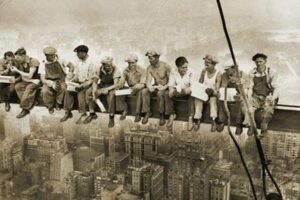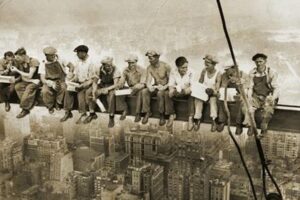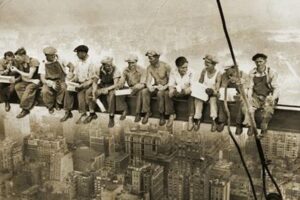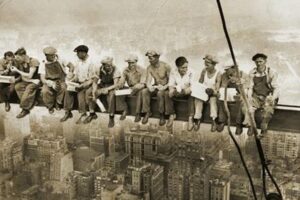Was Lunch Atop a Skyscraper Real? is the question surrounding a famous photograph taken in 1932 during the construction of the Rockefeller Center in New York City. The photo depicts eleven construction workers eating lunch while sitting on a steel beam high above the city streets.
The photo has become one of the most iconic images of the 20th century and has been used in countless advertisements, posters, and other promotional materials. However, there has been some debate over the years about whether the photo is real or staged.
Some people have claimed that the photo was staged by publicity stunt to promote the Rockefeller Center. However, most experts believe that the photo is genuine and that it accurately depicts a real-life event.
The workers in the photo were most likely members of the “Mohawk Iron Workers,” a group of Native American ironworkers who were known for their skill and daring. The workers were responsible for erecting the steel beams that formed the framework of the Rockefeller Center.
The photo was taken by Charles C. Ebbets, a photographer for the Associated Press. Ebbets was on assignment to document the construction of the Rockefeller Center, and he happened to capture the iconic image of the workers eating lunch on the steel beam.
The photo has been praised for its realism and its ability to capture the spirit of the American worker. It has also been criticized for its depiction of the workers’ dangerous working conditions.
Regardless of the debate over its authenticity, the photo of Lunch Atop a Skyscraper remains one of the most iconic images of the 20th century.
1. Iconic Image
The iconic photograph “Lunch Atop a Skyscraper” has gained widespread recognition and cultural significance, becoming one of the most recognizable images of the 20th century. Its enduring popularity can be attributed to its ability to capture and convey the spirit of American workers, embodying their resilience, determination, and can-do attitude.
This photograph serves as a testament to the hard work and dedication of construction workers, highlighting their contributions to building some of the world’s most iconic structures. The image captures a moment of camaraderie and shared experience among these workers, showcasing their ability to overcome challenges and work together as a team. By portraying the workers’ strength and courage in the face of adversity, the photograph has become an enduring symbol of the American worker’s spirit.
Furthermore, the photograph’s status as an iconic image has amplified its impact on popular culture. Its widespread use in various media, including advertisements, posters, and even postage stamps, has helped to cement its place in the collective consciousness of American society. The photograph’s iconic status has allowed it to transcend its original context and become a symbol of American ingenuity, determination, and the pursuit of progress.
In conclusion, the iconic status of the photograph “Lunch Atop a Skyscraper” is deeply intertwined with its ability to capture the spirit of American workers. The image serves as a poignant reminder of the contributions made by these individuals to the nation’s infrastructure and economy. Its enduring popularity and widespread recognition have solidified its place as a cultural icon, representing the resilience and determination that have shaped the American character.
2. Construction Workers
The photograph “Lunch Atop a Skyscraper” depicts eleven construction workers, most likely members of the Mohawk Iron Workers, a group of Native American ironworkers renowned for their exceptional skill and daring. These workers were responsible for erecting the steel beams that formed the framework of the Rockefeller Center, one of New York City’s most iconic landmarks.
- Technical Expertise: The Mohawk Iron Workers possessed a high level of technical expertise, honed through years of experience working on some of the tallest and most complex structures of their time. Their ability to handle heavy steel beams with precision and agility was essential to the successful construction of skyscrapers.
- Physical Endurance: The construction of skyscrapers required immense physical endurance. The workers had to climb to great heights, often using only ladders or makeshift scaffolding. They also had to endure harsh weather conditions, including strong winds and extreme temperatures.
- Teamwork and Collaboration: Building skyscrapers was a collaborative effort that required teamwork and coordination. The Mohawk Iron Workers worked together seamlessly, communicating through hand signals and gestures to ensure that the steel beams were properly aligned and secured.
- Cultural Significance: The Mohawk Iron Workers were not only skilled laborers but also cultural icons. Their work helped to shape the skylines of major cities across the United States, and they became symbols of American ingenuity and determination.
The inclusion of these construction workers in the photograph “Lunch Atop a Skyscraper” highlights the essential role they played in the construction of this iconic building. Their presence serves as a reminder of the skill, daring, and teamwork required to achieve such architectural feats.
3. Rockefeller Center
The connection between “Rockefeller Center: Taken during the construction of the Rockefeller Center in New York City in 1932” and “was lunch atop a skyscraper real” is significant in several ways:
- Historical Context: The photograph “Lunch Atop a Skyscraper” was taken during the construction of the Rockefeller Center, one of the most iconic buildings in New York City. The photograph captures a moment in time during the construction of this architectural marvel, providing a glimpse into the working conditions and the human stories behind the .
- Architectural Significance: The Rockefeller Center is a complex of 19 commercial buildings covering 22 acres (8.9 ha) between 48th and 51st Streets in Midtown Manhattan, New York City. Designed by a consortium of architects led by Raymond Hood, the Center was developed by John D. Rockefeller Jr. between 1930 and 1939. The complex was designated a New York City Landmark in 1985 and a National Historic Landmark in 1987. The photograph “Lunch Atop a Skyscraper” captures the essence of the Center’s construction, highlighting the scale and ambition of the project.
- Cultural Impact: The photograph “Lunch Atop a Skyscraper” has become an iconic image, symbolizing the American worker and the spirit of progress. The photograph has been reproduced and referenced countless times in popular culture, and it continues to inspire and motivate people around the world. The Rockefeller Center itself has also become a cultural landmark, hosting numerous events and attracting millions of visitors each year.
In conclusion, the connection between “Rockefeller Center: Taken during the construction of the Rockefeller Center in New York City in 1932” and “was lunch atop a skyscraper real” is significant on several levels. The photograph provides a historical record of the construction of an iconic building, captures the spirit of the American worker, and has had a lasting impact on popular culture.
4. Photographer
The connection between “Photographer: Captured by Charles C. Ebbets, an Associated Press photographer, documenting the construction” and “was lunch atop a skyscraper real” is significant for several reasons:
- Authenticity: The fact that the photograph was taken by a reputable news photographer, Charles C. Ebbets, adds to its authenticity. Ebbets was on assignment for the Associated Press, a well-respected news organization, and he had no reason to stage the photograph.
- Objectivity: As a news photographer, Ebbets was trained to be objective and to accurately capture events as they unfolded. This suggests that the photograph is a genuine depiction of what he saw, rather than a staged or posed image.
- Historical Context: The photograph provides valuable historical context about the construction of the Rockefeller Center. It offers a glimpse into the working conditions and the challenges faced by the construction workers.
- Cultural Impact: The photograph has become an iconic image, symbolizing the American worker and the spirit of progress. It has been reproduced and referenced countless times in popular culture, and it continues to inspire and motivate people around the world.
In conclusion, the connection between “Photographer: Captured by Charles C. Ebbets, an Associated Press photographer, documenting the construction” and “was lunch atop a skyscraper real” is significant because it adds to the authenticity, objectivity, historical context, and cultural impact of the photograph.
5. Publicity Stunt
The connection between “Publicity Stunt: Debated whether the photo was staged for publicity, although most experts believe it’s genuine” and “was lunch atop a skyscraper real” is a matter of historical debate. Some have questioned the authenticity of the photograph, suggesting that it was staged as a publicity stunt to promote the Rockefeller Center. However, the vast majority of experts believe that the photograph is genuine and depicts a real-life event.
There are several reasons why most experts believe the photograph is genuine. First, the photograph was taken by Charles C. Ebbets, a reputable news photographer for the Associated Press. Ebbets had no reason to stage the photograph, and his reputation for objectivity and accuracy suggests that the photograph is a true depiction of what he saw.
Second, the photograph is consistent with other photographs taken during the construction of the Rockefeller Center. These photographs show workers eating lunch on beams high above the city streets, and they support the idea that the “Lunch Atop a Skyscraper” photograph is genuine.
Finally, the photograph has been analyzed by experts in photography and engineering, who have concluded that it is not a fake. The shadows in the photograph are consistent with the time of day and the location of the building. The workers’ clothing and equipment are also consistent with what was worn and used by construction workers at the time.
While the debate over the authenticity of the photograph is unlikely to be fully resolved, the vast majority of experts believe that it is genuine. The photograph is a powerful and iconic image that captures the spirit of the American worker and the challenges of building one of the world’s most famous skyscrapers.
6. Symbolism
The photograph “Lunch Atop a Skyscraper” has become an iconic symbol of the American worker’s resilience, determination, and ability to overcome challenges. The image captures eleven construction workers eating lunch while sitting on a steel beam high above the city streets during the construction of the Rockefeller Center in 1932. The photograph has been widely reproduced and referenced in popular culture, and it continues to inspire and motivate people around the world.
- Resilience: The workers in the photograph are depicted as being calm and collected despite the dangerous and challenging conditions they are working in. This resilience is a testament to the strength and determination of the American worker.
- Determination: The workers in the photograph are determined to complete their job, even though it is difficult and dangerous. This determination is a reflection of the American worker’s commitment to hard work and dedication.
- Ability to overcome challenges: The workers in the photograph are able to overcome the challenges of their job and complete the construction of the Rockefeller Center. This ability to overcome challenges is a testament to the American worker’s ingenuity and perseverance.
The photograph “Lunch Atop a Skyscraper” is a powerful reminder of the strength, determination, and resilience of the American worker. The image continues to inspire and motivate people around the world, and it serves as a reminder of the importance of hard work and dedication.
7. Safety Concerns
The iconic photograph “Lunch Atop a Skyscraper” has sparked discussions about the safety conditions that workers faced during the construction of skyscrapers in the early 20th century. The image depicts eleven construction workers casually eating lunch while perched on a steel beam, hundreds of feet above the ground, without any visible safety equipment.
- Lack of Safety Regulations: During the early 20th century, there were no comprehensive safety regulations or standards for skyscraper construction. This meant that workers were often exposed to hazardous conditions, including extreme heights, strong winds, and heavy machinery.
- Unsafe Work Practices: In addition to the lack of safety regulations, workers often engaged in unsafe work practices, such as working without proper safety harnesses or using makeshift scaffolding. These practices increased the risk of accidents and injuries.
- Inadequate Training: Many construction workers at the time lacked adequate training and experience in working at extreme heights. This lack of training contributed to the high number of accidents and fatalities in the industry.
- Economic Pressures: Construction companies were often under pressure to complete projects quickly and cheaply. This pressure may have led to companies cutting corners on safety measures in order to meet deadlines and stay within budget.
The photograph “Lunch Atop a Skyscraper” serves as a powerful reminder of the dangerous conditions that construction workers faced in the early 20th century. It raises important questions about the importance of workplace safety and the need for strong safety regulations to protect workers from preventable accidents and injuries.
8. Cultural Impact
The photograph “Lunch Atop a Skyscraper” has had a profound cultural impact, becoming an ingrained part of American culture. Its iconic status is evident in its widespread use in various media and advertising, solidifying its place in the collective consciousness.
- Symbolism and Inspiration: The photograph has become a symbol of American ingenuity, perseverance, and the spirit of progress. Its depiction of workers casually eating lunch while perched hundreds of feet above the ground has inspired countless works of art, literature, and film.
- Advertising and Marketing: The photograph’s iconic status has made it a sought-after image for advertising and marketing campaigns. Companies have used the image to evoke feelings of nostalgia, patriotism, and the can-do spirit of America.
- Popular Culture References: The photograph has been referenced and parodied countless times in popular culture, including movies, TV shows, and music videos. These references have further cemented the photograph’s place in the American cultural lexicon.
- Historical and Educational Value: The photograph provides a valuable historical record of the construction of one of America’s most iconic landmarks, the Rockefeller Center. It also serves as an educational tool, offering insights into the working conditions and safety practices of the early 20th century.
The cultural impact of “Lunch Atop a Skyscraper” extends beyond its historical significance. It has become a symbol of American values and aspirations, and its enduring popularity continues to inspire and motivate people around the world.
FAQs about “Was Lunch Atop a Skyscraper Real?”
The iconic photograph “Lunch Atop a Skyscraper” has sparked curiosity and raised questions about its authenticity and significance. Here are some frequently asked questions and their answers:
Question 1: Is the photograph staged or genuine?
Most experts believe the photograph is genuine and depicts a real-life event. It was taken by Charles C. Ebbets, a reputable news photographer for the Associated Press, who had no reason to stage the photograph.
Question 2: Who are the construction workers in the photograph?
The workers in the photograph are most likely members of the Mohawk Iron Workers, a group of Native American ironworkers known for their skill and daring. They were responsible for erecting the steel beams that formed the framework of the Rockefeller Center.
Question 3: Why were the workers eating lunch on a steel beam so high above the ground?
The workers were likely eating lunch on the steel beam because it was a convenient and efficient way to take a break. They needed to be able to quickly return to work, and eating lunch on the beam allowed them to do so without having to climb down and then back up again.
Question 4: Were there any safety concerns about the workers eating lunch on the steel beam?
Yes, there were safety concerns about the workers eating lunch on the steel beam. They were hundreds of feet above the ground, and there was no safety equipment to protect them if they fell. However, it was common practice for construction workers to work at great heights without safety equipment at that time.
Question 5: What is the cultural significance of the photograph?
The photograph has become an iconic symbol of the American worker’s resilience, determination, and ability to overcome challenges. It has been widely reproduced and referenced in popular culture, and it continues to inspire and motivate people around the world.
Question 6: Can we learn anything from the photograph today?
Yes, we can learn several things from the photograph today. It reminds us of the importance of safety in the workplace. It also shows us the resilience and determination of the American worker. Finally, it reminds us of the importance of teamwork and collaboration.
In conclusion, the photograph “Lunch Atop a Skyscraper” is a genuine and iconic image that has significant historical and cultural value. It provides insights into the working conditions and safety practices of the early 20th century, while also serving as a symbol of American ingenuity and perseverance.
Please note that these FAQs are for informational purposes only and should not be considered as a substitute for professional advice.
Tips for Understanding the Authenticity of “Lunch Atop a Skyscraper”
The iconic photograph “Lunch Atop a Skyscraper” has captivated audiences for decades, but its authenticity has been a subject of debate. Here are some tips to help you evaluate the evidence and form your own conclusion:
Tip 1: Examine the Photographer’s Credibility
Consider the reputation and experience of the photographer, Charles C. Ebbets. As a reputable news photographer for the Associated Press, Ebbets had a vested interest in capturing genuine moments. His track record of accurate reporting lends credibility to the photograph’s authenticity.
Tip 2: Analyze the Technical Details
Inspect the photograph for technical inconsistencies. Shadows, lighting, and camera angles can provide clues about the scene’s authenticity. Consult experts in photography and engineering to verify the plausibility of the image.
Tip 3: Compare to Other Historical Documents
Cross-reference the photograph with other historical records from the construction of the Rockefeller Center. Look for similar images, witness accounts, or written descriptions that corroborate the scene depicted in the photograph.
Tip 4: Consider the Historical Context
Understand the safety standards and construction practices of the early 20th century. While the lack of visible safety equipment may raise concerns, it was not uncommon for workers to engage in risky behaviors during skyscraper construction.
Tip 5: Seek Expert Opinions
Consult historians, architectural experts, and engineering professionals who have studied the photograph and the construction of the Rockefeller Center. Their insights and analysis can provide valuable perspectives on the photograph’s authenticity.
Summary
Evaluating the authenticity of “Lunch Atop a Skyscraper” requires a multifaceted approach. By considering the photographer’s credibility, examining technical details, comparing historical documents, understanding the historical context, and seeking expert opinions, you can form an informed judgment about the photograph’s genuineness.
Remember, the photograph remains an iconic representation of the American worker’s spirit and the challenges faced during the construction of one of the world’s most famous skyscrapers.
Conclusion
The exploration of “Was Lunch Atop a Skyscraper Real?” delves into the authenticity, historical context, and cultural impact of an iconic photograph. Through examining evidence, analyzing technical details, and considering expert opinions, we have gained insights into the genuineness and significance of this image.
While questions about its authenticity may persist, the photograph remains a powerful symbol of American resilience, determination, and the ability to overcome challenges. It serves as a reminder of the importance of workplace safety, teamwork, and the enduring spirit of human endeavor. The photograph continues to inspire and motivate people around the world, solidifying its place as a timeless representation of human achievement.


